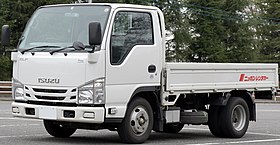| Isuzu Elf | |
|---|---|
 | |
| Overview | |
| Manufacturer | Isuzu |
| Also called |
|
| Production | 1959–present |
| Assembly |
|
| Body and chassis | |
| Class | Medium-duty truck |
| Body style |
|
| Related |
|
| Chronology | |
| Predecessor | Bedford TK/Bedford TL (United Kingdom) Chevrolet Kodiak (Chevrolet models) Isuzu H-Series (United States) GMC L-Series |
The Isuzu Elf (Japanese: いすゞ・エルフ, Isuzu Erufu) is a medium duty truck produced by Isuzu since 1959. Outside Japan it is known as N series and Q Series. The range was originally mainly available in Japan and other Asian countries. Australia was another important market for the Elf and N series – to the extent that it was manufactured there from the 1970s using many local components. Since the early 1980s, it has also been sold and built in the United States (under the Chevrolet and GMC brands as a W-Series), and also as the Isuzu N-Series. Only North America receives the wide-cab version.
For the common Andinian market (including Chile and Peru), the truck has been assembled in the GM-Colmotores assembling plant in Bogotá, Colombia since 1991, with annual quantities already of 20,000 up to 60,000 units. Local assembly has been increasing because of increasing demand in the Colombian and neighboring markets. It carries "Tecnología Isuzu" (with Isuzu Technology) lettering.
In Indonesia, Philippines and several other countries, the Elf is not only used as a truck, but also converted into microbuses by local body makers. The lighter four-wheeled models are commonly used as an intercity Angkot or Jeepney (share taxis), as a school bus, or as an employee bus. Indonesian conversions typically use car-style hinged doors and usually resemble a high-roof van, while most conversions in Kenya, and newer ones in the Philippines often resemble a minibus, with a folding door on the side for passengers, and standing room.
- ^ "None". Archived from the original on 7 January 2010.
- ^ "Bedford NKR". 12 October 2012. Retrieved 4 September 2021.
- ^ "Supply of Vehicles Manufactured by Isuzu Motors Limited for North America" (PDF). hino-global.com. Retrieved 14 August 2023.
- ^ "翼放_车型展厅_江西五十铃汽车".
- ^ "Chinese Car Brands That Time Forgot: Fuzhou Automobile Works and Forta". 6 February 2018.
- ^ "ISUZU:Principal Overseas Subsidiaries, Affiliates and Offices". www.isuzu.co.jp. Archived from the original on 17 April 2021. Retrieved 7 September 2020.
- ^ a b "Isuzu deslocaliza produção de Vendas Novas para Itália". Transportes & Negócios (in European Portuguese). 13 February 2014. Retrieved 26 December 2019.
- ^ "Pabrik Mobil Isuzu di Karawang Rp 1,7 Triliun Resmi Beroperasi" [1.7 trillion Isuzu car factory in Karawang is officially in operation]. Detik Finance (in Indonesian). detikcom. 7 April 2015. Archived from the original on 9 August 2020.
- ^ LEUTE, JAMES P. (20 April 2009). "Thursday is last day of production as Isuzu line comes to end". gazettextra.com.
- ^ "Isuzu celebrates 20,000 unit milestone for N-Series gas-powered Cabover". 27 April 2015.